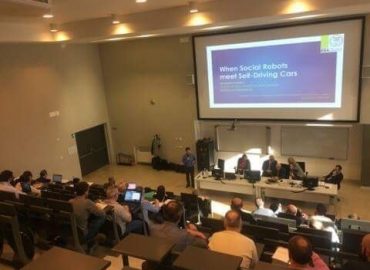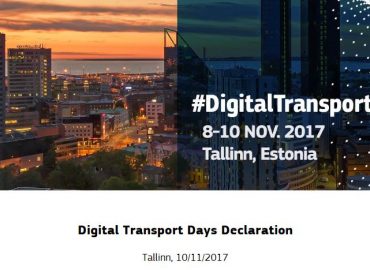Viktor Stromcek, the State Secretary of the Slovak Ministry of Transport, shared with Portal his thoughts on intelligent transport systems and Slovakia’s role in the transition to an autonomous transport future.
Intelligent Transport Systems: a Tool or a Toy?, held in November in Žilina, Slovakia, took as its theme the role of research and industrial organisations in shaping the future of intelligent transport systems (ITS) in Europe, with particular attention being paid to autonomous driving and mobility as a service. Organised by COST (European Cooperation in Science and Technology) and the University of Žilina, and supported by ERTICO (a platform for the development and deployment of ITS in Europe), the two-day event was held under the auspices of the Slovak Presidency of the Council of the European Union, a role the country assumed from the Netherlands in July 2016 and handed over to Malta at the beginning of January this year.
On the sidelines of the conference, Portal met with Viktor Stromcek, the State Secretary of the Ministry of Transport, Construction and Regional Development of the Slovak Republic, to hear his thoughts on intelligent transport systems and how Slovakia is driving the transition to an autonomous transport future.
Which particular areas of intelligent transport systems is Slovakia focusing its efforts on?
When we talk about infrastructure, we are not just talking about highways and railways – we’re talking about highways, railways and intelligent systems, which have become a necessary part of that infrastructure. Say we want to build a new tramway, we want to know how many people use trams, how many use a certain line, and how they can run more efficiently. When we are talking about cars we want to know the capacity of the highways and where the peaks in traffic are – that way we know where best a new road might be built. Let’s say the regions have supplied around €20bn for new infrastructure. It’s very difficult to say which plans or proposals are the best and which ones are a definite no, and you can imagine the tension between authorities and mayors in each region, all of whom think their proposal is needed the most. It’s not easy to decide what to build simply by looking at a plan on the table; we’ve got to have the data from the intelligent system in place before we can make any decisions about new highways or railways infrastructure – that way we’ll know how our decision will impact on transport in reality.
Slovakia is a nice country but a small one, so while it’s very important for us to support all kinds of activities in the area of intelligent transport systems, cross-border activities are particularly crucial. For us, the number one area of importance when considering intelligent transport systems is security, and in that respect it wouldn’t make sense to work alone and do something just for us. That’s why it’s so important to have good co-operation with other countries.
Intelligent transport systems involve a huge amount of new information in the form of data that can be read and used online. So to be a good partner to others, we’ll need to have very good internet coverage – I’m not talking about just SMS and other messaging services, but about 5G and so on. Slovakia has to be ready for that. This is one of the biggest opportunities for the country but, on the other hand, also one of the biggest issues facing us.
These are our main aims in terms of intelligent transport systems.
Is Slovakia looking to incorporate the intelligent transport system into the smart city more generally?
Good state and city co-operation is important in this respect. A good example is our big infrastructure PPP project, which is one of the largest in Europe. It aims to build a ring road around Bratislava and a speedway in a very problematic area of the city. At the moment, this area sees some 30,000 cars travelling across just one simple road, and more than 100,000 cars pass over one bridge each day.
Now we have started to build a new bridge and a new speedway. But we have warned the city to prepare itself, because we will be better with our infrastructure, but whatever we build it will have to continue. We have invested in new trams and new bridges in Bratislava, but all of it is dependent on an intelligent-style system, and the city needs to be ready for that. I think there is some work for both state and the municipalities to do together here. There is a space for better communication and more and
better data.
You mentioned in your welcome address to the conference that policy is always playing catch up with technology. How are you addressing that challenge?
The government never moves as quickly as technological progress. What that means is that we need a good, solid framework, and we have to be ready to support new technology development – whether from a university or business, it doesn’t matter. We want to be a good environment for innovation. We want companies, when they think about technology development, to say, ‘Slovakia would be a good
partner for that’.
Concerning the importance of cross-border collaboration, how is Slovakia looking to expand co-operation with Poland, the Czech Republic and Hungary when it comes to intelligent
transport systems?
We want to have autonomous driving between our countries as soon as possible. Slovakia is the biggest producer of cars per capita worldwide (car producers now account for more than 20% of our economy), and Hungary, the Czech Republic and Poland are also a very big part of car production in the European Union. So Slovakia would like to be a leader in this kind of activity.
Autonomous cars are the end goal. Of course, we understand that this will take time – but it will take time because to do it correctly means taking all the necessary steps. And that opens up opportunities: autonomous driving is the aim, but that doesn’t mean we can’t develop and implement new things in the meantime and along the way. This is what the recent memorandum of understanding signed between the four of us is about. We want to work together to achieve autonomous cars step by step, and within that process we want to involve car producers and other types of companies.
There are a lot of opportunities in autonomous cars for technology providers, for instance, or GSM operators. Indeed, the smart car operators of the future might very well be Apple and Microsoft rather than Kia or Nissan. It’ll be interesting to see who’ll be faster and more proactive in that regard.
How does work within Slovakia translate through dialogue and collaboration with the European Commission? What support is available at the EU level for the kinds of activities Slovakia is engaging in?
I have to say our co-operation with the EU is quite perfect – for two reasons. First, the European Commission is very proactive when it comes to these kinds of opportunities. It hasn’t just sat back and waited for a signal from the member states that they are ready to start thinking about ITS. When I meet with the representatives of the European Commission, it is clear that they really enjoy what they are doing and they enjoy new technologies. They are really passionate supporters of ours. Second, our communication with the European Commission is absolutely without any problems. We really appreciate this, and we think and we hope things will continue to work this way through many more milestones.
Slovakia inherited the council presidency from the Netherlands and will pass it on to Malta. What have you learned from your predecessor’s approach to intelligent transport systems, and what advice will you be passing on to your successor?
The Netherlands presidency did excellent work with regards intelligent transport systems, and I hope that we are continuing that progress successfully. Our recommendation would be the same to Malta – to just continue with this progress. What’s important to remember is that the new technologies we would like to see adopted in the car industry will in the future be mandatory. In a few years, no matter whether a car is €5,000 or €100,000, it will have these new features. That’s a really good thing because they will make driving safer and drivers more comfortable, and are also beneficial from a cost-benefit and ecological perspective.
Viktor Stromcek
State Secretary
Ministry of Transport, Construction and Regional Development of the Slovak Republic
www.telecom.gov.sk
This article first appeared in issue 13 of Horizon 2020 Projects: Portal, which is now available here.



